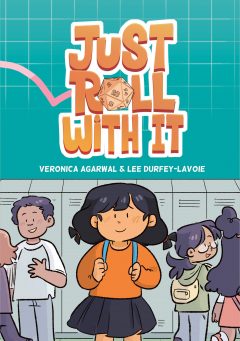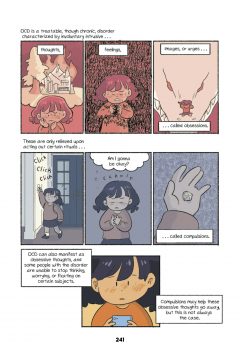Review: Just Roll With It (Random House Graphic)
We’re taking a deep dive into the belly of the beast this week with a return to *shudder* middle-school (secondary school for us Brits!). As a shy newbie, Maggie’s already feeling a little wrong-footed. But if she rolls the right number on her dice, everything will be fine, won’t it? Find out in Veronica Agarwal & Lee Durfey-Lavoie’s debut graphic novel Just Roll with It!
 Publisher: Random House Graphic
Publisher: Random House Graphic
Writer: Veronica Agarwal
Artist: Lee Durfey-Lavoie
Price: £8.99 from Amazon
Just Roll With It begins with an ordinary family dinner. We meet our leading lady Maggie and her sister Jamie, and soon find that Jamie is off to college, and Maggie is about to start sixth grade (year 7 for us Brits!). Yeesh. I’m not sure I’d wish that stomach-churning feeling of starting ‘big’ school on anyone! Whilst Jamie seems excited at the prospect of heading to college, Maggie is much less positive. But Maggie has a secret weapon – her dice, which she rolls to predict a positive or negative outcome to situations. Seen as she has an almost perfect roll this time, she’s hoping there’s no need to worry…
As we delve deeper into our story, it soon becomes apparent that Maggie is struggling with some form of OCD, as she totally relies on her dice rolls to make any and all decisions for her. At first Maggie’s obsession with the dice doesn’t seem THAT dramatic – sure, she’s a little dependent on them, but she’s a shy kid! She uses the dice to choose which way to navigate to the lunchroom and whether to answer a question in class. Just meaningless day to day decisions, right?
Wrong. It becomes increasingly obvious that allowing her dice to make all her decisions is becoming incredibly damaging. The dice rolls begin to negatively affect her relationship with her new friend Clara, whether she can participate in activities and even when she can go to bed. We also realise that Maggie is suffering with anxiety when she sees her new friend Clara speaking to some other children: what if Clara’s talking about her? Are they laughing at her? It’s better to just hide away. This all comes to a serious climax when Maggie’s sister is really ill, and Maggie finds herself unable to move to her as the dice dictates a negative outcome.
 As the graphic novel goes on, we explore important subjects like OCD and anxiety more and more through the eyes of Maggie – this is definitely a great book to introduce younger readers to these concepts, or, if they’re struggling with them themselves, to feel represented and less alone. There’s also a fun side story that kids will enjoy about a creature lurking in the school grass that accompanies the main narrative. Young readers who are into fantasy will particularly enjoy the ‘DnD’ style club that Maggie and Clara join, and their various adventures.
As the graphic novel goes on, we explore important subjects like OCD and anxiety more and more through the eyes of Maggie – this is definitely a great book to introduce younger readers to these concepts, or, if they’re struggling with them themselves, to feel represented and less alone. There’s also a fun side story that kids will enjoy about a creature lurking in the school grass that accompanies the main narrative. Young readers who are into fantasy will particularly enjoy the ‘DnD’ style club that Maggie and Clara join, and their various adventures.
Whilst I’m definitely not the target audience for this one, I can really appreciate the work Veronica Agarwal & Lee Durfey-Lavoie put into making a graphic novel about serious illnesses into this accessible form for young readers – though a lot of information about OCD and anxiety is out there, it’s not always easy to go searching or understand the information you’re looking at, so having this book as a resource is definitely a positive. I also have to give a shout out to the representation in this – the art itself was cute and fun, but it was brilliant to see so much diversity on every colourful, happy page!



October 9, 2025 @ 3:40 am
I appreciate the effort put into this post. Watch bbc persian farsi — Persian‑language breaking news, in‑depth reports, talk shows, and documentaries for Iran, Afghanistan, and the region. Reliable HD stream on any device.